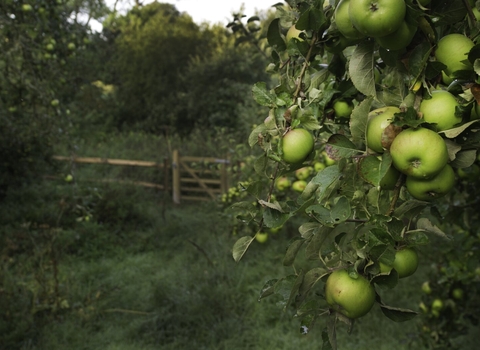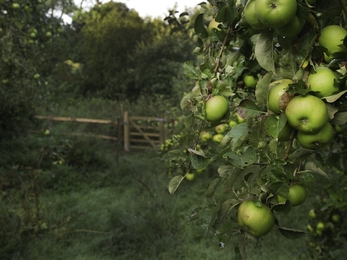Why manage an orchard?
Orchards in the UK are home to an abundant variety of wildlife. From green woodpeckers, to clumps of mistletoe, there are thousands of species that enjoy the micro-habitats and bountiful feast that orchards provide. So whether you have just a few fruit trees in your garden, or you manage a large orchard, you can play your role in helping wildlife.
The wildlife within your orchard will be reliant on active management of the trees and the grassland underneath them. Retaining mature trees through pruning, planting new trees to give the orchard longevity and cutting and clearing the grass on an annual basis will all help wildlife to thrive.
Orchards provide a real sense of connection between people and nature. They are the outcome of our symbiotic relationship with the land, where we help wildlife to flourish and receive a glut of delicious fruit in return. By managing orchards you can help bring benefits to both wildlife and people.
Where do I start?
Assess the condition of your orchard. Fruit trees can be long-lived and grow up to 5m in height, depending on their rootstock. But they can be prone to disease. The first thing to look for is any trees that show signs of disease, decay or deadwood. You should remove any diseased wood in particular, ideally taking it out of the orchard to prevent any spores infecting any other trees. Traditionally, deadwood was removed from fruit trees to promote new growth and to prevent any disease from spreading into neighbouring trees. However, for wildlife, that deadwood is anything but dead. It will be packed full of invertebrates, bringing in species such as woodpeckers to feed on them. Therefore, we suggest you retain some deadwood in your orchard, but monitor it to ensure it has no other negative effects on the tree.
If you are happy that your trees are in good health, assess what species you have. Knowing whether you have apples, pears, plums, cherries or any other type of fruit tree will better inform your management. Making a plan of the orchard, noting what kind of tree is where, can be a worthwhile task, as is physically labelling the trees. You can identify them down to a variety (granny smith, Cox’s orange pippin, Victoria plum, etc.) if you wish, which may help you to use the fruit, however, this isn’t essential.
Once you know what fruit trees you have, where they are and that they are in a good condition, you can move on to the ongoing management of your orchard.
How do I manage my orchard?
The trees
Fruit trees need regular pruning if they are to remain healthy and productive. This varies depending on the type of fruit tree that you have, with stone fruits being pruned in the summer and apples and pears being pruned in the winter to promote new growth and then again in the summer to prohibit new growth. The general idea is to give the tree a shape that allows it to avoid being damaged through the branches rubbing, as well as changing the chemical balance in the tree to promote new growth in the right areas.
Winter pruning
Pruning in the winter should only take place on apples and pears. This is due to silver-leaf being prevalent at this time of year, a disease which affects stone fruits such as plums and cherries and which will enter the trees from open cuts. With all pruning, you don’t want to take more than 30% of the entire canopy of the tree. If you exceed this, you will encourage watershoots to grow, which are vertical, young shoots that are very energy hungry. This limits the fruit your tree will produce and will also negatively affect the shape of your trees.
The first thing to do is remove any wood that is showing signs of disease, decay or that is already dead (retaining some deadwood in mature trees is advised as mentioned above). Keep the cuttings in a pile by the tree so you can easily assess if you are close to removing 30% of the canopy. If you haven’t reached 30%, you can then prune for shape. Aim to retain strong, horizontal branches. These will be able to support the weight of the fruit in the autumn and will encourage growth away from the trunk of the tree. This might feel counter-intuitive, to cut bits of the tree you have lovingly planted, but pruning is the key to keeping fruit trees healthy.
If you're removing healthy branches don't remove them all from site, a pile of branches in a corner of the orchard will provide shelter and food for a range or insects and hedgehogs over the winter.
Summer pruning
This is the time to prune soft fruit trees like cherries, plums, damsons etc but apple and pear trees can also be pruned at this time of year provided you didn’t remove 30% of their canopy in the winter. Pruning in July can be used to prohibit growth, so this is the time to remove any watershoots (fresh growth from this year) growing in the middle of the soft fruit trees. You should also remove anything that is dead, diseased or dying, as per winter pruning.
You can also remove some of the fruit in July if you have a heavy crop. This stops the weight of the fruit from breaking the branches, whilst also encouraging better quality of apples, rather than a large number of smaller apples. Don’t do this before July as most fruit trees drop some fruit naturally in June. So see what it drops itself and remove more if needed.
Planting a new orchard
What you will need for an orchard is roughly 10m x 10m of open space as a minimum. An orchard should be at least five fruit trees, which usually need to be planted at least 3m apart in all directions.
You then need to decide what type of fruit you want and which varieties as well. Keep in mind that some fruit trees have pollinator groups, which indicates what other varieties they will pollinate with. It is worth trying to get at least two trees from any pollinator group to ensure a good crop. There are plenty of resources online that will tell you what varieties are in which pollinator group.
You will have to decide on what rootstock to get your trees on. Fruit trees are grafted on to rootstocks that determine how large the tree will eventually grow to. An MM106 rootstock will give you an apple tree of about 2-3m tall. Whereas a M27 will give you an apple tree of no more than 1m tall. Once you have picked the right rootstock to give you trees that fill your orchard, you can see how far apart they will need spacing. There is more information on rootstocks on the RHS website.
Trees should be planted in winter once they are dormant. Remove a 1m x 1m square of turf and dig a hole big enough to get the whole rootball of the fruit tree into. Make sure the hole is square, as this will encourage the roots to spread outwards as they grow. Place the roots into the hole and back fill with the soil. Be careful not to cover the graft (the bumpy bit about 1ft up the trunk of the tree) with soil. Put down some natural matting, such as coconut matting, around the area your cleared of turf and then cover with a well-rotted mulch of bark. This feeds the tree and stops competition from other plants, allowing your tree to get a good start in life.
Your tree won’t produce a good fruit crop for at least 2-3 years. In the first year, pinch off any fruit as this will allow the tree to put its energy into growing rather than wasting it on small fruits. It is then simply a case of waiting for the tree to grow and doing some pruning to encourage good form.
Once your trees are established, planting wildflowers around them can provide a nice addition to the orchard. For more information on wildflowers visit our meadow advice page.
If you would like help in creating an orchard, visit our services page for more information.





